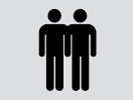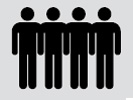24 October 2014
Billy Graham and the letter that saved 38,000 lives
Billy Graham's legendary mission took place more than half a century ago, but today it still boasts the title of being the largest Christian event in the UK. Ever. And it was triggered by one seemingly insignificant letter to the Evangelical Alliance. As the 60th anniversary of the Greater London Crusade is celebrated this year, Amaris Cole looks back at how it began.
The Harringay Crusade saw 38,000 people give their lives to God. Nearly two million people attended the 12-week crusade, which spanned from 1 March to 22 May 1954. This was the closest Britain came to revival in the 21st century, but this mighty mission had humble beginnings.

More than 38,000 registered adecision to convert – the number of people who live in the Lake District.

An estimated 50,000 people attended Hyde Park on Good Friday to hear Billy Graham preach – the number who watched One Direction at Man City's stadium.

Grand total of attendance for the Crusade 1,047,300 – more than four times the population of Liverpool.
"In the middle of September 1951 a letter from Philadelphia, reached the secretary of the Evangelistic Alliance in London. It was from the Rev Ralph W Mitchell, secretary for evangelism of the Pocket Testament League. There was nothing particularly significant about the letter apart from one sentence;and that sentence simply offered a suggestion. It was to the effect that a young American evangelist, by the name of Billy Graham, might be invited to Britain for an evangelistic crusade in the not too distant future," wrote Frank Colquhoun in The Official Record of the Billy Graham Greater London Crusade 1954.
Graham was already known in the UK. From 1944, he was involved in a host of evangelistic Youth For Christ meetings across Britain, though not everyone approved. "Stanley Barker, for example, the evangelistically minded minister of Bordesley Green Baptist Church in Birmingham, was unconvinced that the way to reach 95 per cent of people in Birmingham who allegedly did not attend church was through 'surplus saints', as he labelled them, from America."* This changed when the pair met, though. In fact, the former sceptic was so convinced of Graham's ability to evangelise that he "engaged in frantic telephoning of his contacts", urging each of them to attend the youth meetings in the area, seeing attendance rise to 2,500. This was the power of Graham: his charisma and love of God won over even the strongest cynic. This set the stage for the possibility of a crusade – an idea that was germinating with church leaders both here and across the pond.
The Festival of Britain came next. The hunger for evangelism intensified and public meetings were held during the 1951 festival to move plans ahead for a major evangelical 'Exhibition', which would serve as a warm-up for the Crusade. The Alliance was pivotal to this. Executive officer Roy Cattell brought together a group of 160 evangelical organisations to get behind the exhibition. They agreed the slogan should be 'For Such a Time as This'. It was said to show evangelical unity and strength of character "on a scale never before seen". The Alliance knew it could do still more, and planned to organise a mission "of still greater service to the evangelical world". But how?
Then the letter arrived. Graham was secured as America's foremost evangelist, having converted top celebrities in the US, such as Louis Zamperini, an Olympic track star and Stuart Hamblen, a popular cowboy singer. So in 1952, John Cordle and Roy Cattell went to the United States to, as Graham himself put it, "try to talk me into accepting their invitation to hold a Crusade". He added: "They impressed me with their burden for England;they expressed themselves eloquently about the social and spiritual problems there since the war."Signalling his willingness to carry out the Crusade, the stage was set. Committees and subcommittees were established in June 1953 by the Alliance to organise different elements of the crusade, including prayer, literature, publicity, counselling and perhaps most importantly, evangelism – no detail was missed.

Digging through the archive at the Alliance's office today uncovers an account from Evangelical Christendom in 1954
Evangelical Christendom, the Alliance's publication at the time, said that "statistics alone are a very poor medium for conveying the wonderful story of the Greater London Crusade". But the figures truly are staggering. During the course of the Crusade, 1,756,300 people attended the stadiums to hear Billy Graham preach. A further 116,500 attended additional meetings and services conducted by Mr Graham, and 174,500 were reached by serves led by his team.
The Evangelical Alliance was clearly integral to the logistical and spiritual success of the 12-week tour. The crusade united Christians in mission from across the country and indeed the world to speak together in one voice. The crusade spoke confidently and effectively in voice to a post-war generation who were desperate for the gospel. Times may have changed, but the work of the Alliance has not.
*One Body in Christ: The History and Significance of the Evangelical Alliance by Ian Randall and David Hilborn
The work of Billy Graham continues today. My Hope UK with Billy Graham is a nationwide effort to reach people across the United Kingdom with the gospel. During the 60th anniversary of the 1954 Harringay meetings and the 30th anniversary of Mission England, churches are being encouraged to bring the same gospel message to their communities through the resources available. Through this outreach, churches can present others with powerful testimonies and a recent message from Billy Graham. For more information and to find these resources, visit the My Hope UK website here.
You might also be interested in
- 21 Feb 2018 Billy Graham's life
- 21 Feb 2018 Billy Graham & the Alliance
- 06 Oct 2017 A holy huddle or a light which cannot be hidden?
- 31 Jul 2018 The Evangelical Alliance to lead a series of seminars at the Christian Resources Exhibition
- 23 Jul 2018 Engaging with your South Asian neighbours

